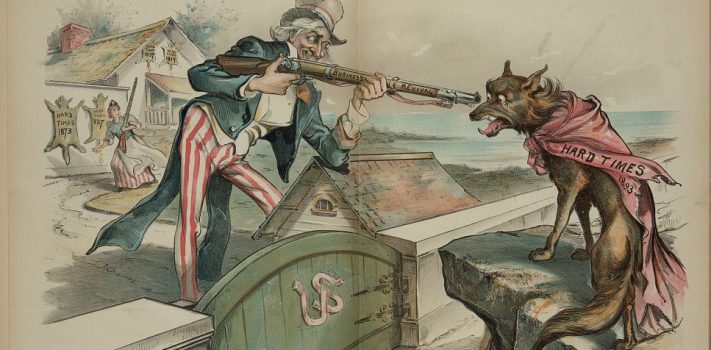Email a copy of 'Economics & Investing For Preppers' to a friend
4 Comments
- Ad USA Berkey Water Filters - Start Drinking Purified Water Today!#1 Trusted Gravity Water Purification System! Start Drinking Purified Water now with a Berkey water filtration system. Find systems, replacement filters, parts and more here.
- Ad Civil Defense ManualThe Civil Defense Manual... The A to Z of Survival. Look what in it... https://civildefensemanual.com/whats-in-the-civil-defense-manual/


The inverting yield curve is the Deep State’s new issue in the OrangeManBad idiocy. HTreasurere’s some interesting information. First, the 10 year – 2 year part of the curve is more important than the 10 year minus 3 month one because market forces play a
more important role in the 2 year Treasuries than in the shorter term issues. And the 10-2 curve has not yet inverted, although it’s close. The importance of this is that there are still gains to be had in stocks after an inversion.
The last time the yield curve inverted was January 2006. Stocks went up 26% over the next 21 months, peaking in October 2007. The yield curve inverted in September of 1998, and the market topped out in August of 2000. Between those dates and market went up 55%, and tech stocks went up 210%.
None of this means the same thing will necessarily happen after the next inversion. The point is not to be scared out of otherwise well-chosen investments. A further implication is the absolute necessity for a disciplined approach to selling. I’m a believer in the use of trailing stops, as I’ve mentioned before.
If we assume, for the purposes of discussion, no TEOTWAWKI event in the next 10 years, the technology that’s coming along will transform our world faster than anything we’ve ever seen. And on a totally different topic, did anyone notice that Trump started a government program to protect the country from an EMP event?
Good stuff Doc. Well said
More thoughts on what may come. The chances of a short recession are very small. The Bank for International Settlements did a study of 32,000 businesses in 14 countries. They found that 12% of these firms are so-called “zombie companies.” This means that they are at least 10 years old, and that they are not earning enough money to pay their ongoing debt obligations. When a crisis hits, these companies will quickly have to fold or be sold. This means that a downturn will tend to be hard and long, not shallow and short.
For investors, a significant part of invested wealth is held by retirees and pre-retirees. A significant part of this money is held in index funds, with the owners following a buy and hold approach, that is, ride the market down and then back up. Their experience from 2008 to today supports that. Unfortunately, the next crisis may well take 20 years or more to work itself out. These investors do not have that much time! What will they do when their wealth evaporates? Remember too that many pension funds index and follow a buy and hold approach as well. Insurance companies invest substantially in fixed income assets, mostly investment grade corporate bonds. They use this money to pay annuity recipients and insurance beneficiaries. The average investment grade corporate bond is now rated BBB, which is one level above junk. What will happen to retirees who depend on the insurance companies when the bonds in their portfolios start to shift into default?
This means that investors MUST have an exit strategy, a discipline that tells them when it is time to get out of stocks, out of bonds, and into cash and precious metals. Barterable goods may be important as well — think bars of soap, boxes of ammunition, bottles of bourbon, etc. I do not suggest overloading on these, just having some. Skills will be important as well, and are much more portable than boxes of stuff.
Just a few random thoughts.
Re: Don’t go to college
I think people need to be careful with the generalized anti-college rhetoric. Currently a liberal arts degree is pretty worthless. However STEM and certain medical degrees are well worth it. And while currently the country needs skilled labor (such as welders) I have watched the inflation adjusted price of skilled labor drop 25% in my working life adjusted for inflation. My nephew iron worker working in the same geographic area I did in 1981 makes 25% less than I did. (BTW he attributes much of that to illegals who despite being illegal have Rock solid documents they purchase). Interestingly I recently went through some of my father’s papers from just before he passed in 1978. They included some pay stubs that tell the same story.
This is not to say college is for everyone. Some (maybe most) should go into trades. Just don’t shout the anti-college rhetoric from the hill tops with a significant part of the story buried in the fine print.
Interestingly Adam Smith addressed this very issue in “The Wealth of Nations” published in 1776. He pointed out that an educated man of his day would be repaying college debt for a long time and that he better count the cost vs benefit wisely. He also stated that a London carpenter of the day typically lasted for eight years before they were too injured and or broken down to work anymore sometimes thrusting them into poverty. He concluded that both approaches carried significant risk. Which is an ongoing theme in his writing. Life is a battle regardless of the path you take.